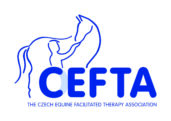The effects of hippotherapy
Hippotherapy effects are divided into direct and indirect. However, everything is happening in interdependence – see the diagram below.
Diagram: Hippotherapy effect on posture (Herman, Horňáček, 2005)
Let´s address the direct effects in the first instance, especially those we use the most in hippotherapy with children in early care:
- Activating of the erector mechanisms is a response of CNS to spatial and time summation of afferentation (e.g. contact of the support zones = a precisely defined contact points between client’s body and horseback; regular gravity deflecting; reflex (cerebellar), internal and external motivation to maintain
 selected position on a horse).
selected position on a horse). - Muscle tone normalization – a rhythmic movement of the horse’s back and heat of horse body specifically affect pathological muscle tone in the sense of normalization (e.g. positively affects hypertonia, spasticity or hypotonia).
- Movement differentiation – three-dimensional movement of the horseback and the similarity of horse step mechanism with human bipedal locomotion directly activates contralateral movement pattern.
- Multi-sensory afferent stimulation – the summation of tactile, proprioceptive, interceptive and sensory stimuli.
- Stimulation of locomotion patterns – all positions applied in hippotherapy have certain sequence and respect the developmental kinesiology. Required movement patterns are stimulated under these preconditions.
- Improving of motor planning and perception of body image – correct interpretation of sensory inputs is necessary for good quality motor planning. The horse and its movement offer tactile, proprioceptive, vestibular, visual, auditory and emotionally tinged stimuli. This motion experience affects the body image awareness.
 Other, but no less important effects are:
Other, but no less important effects are:
- Prevention and treatment of contractures.
- Activation of deep stabilization system.
- Activation of the vestibular system and spatial awareness.
- Influencing of stability, balance and coordination.
- Movement patterns re-education.
Komentáře

